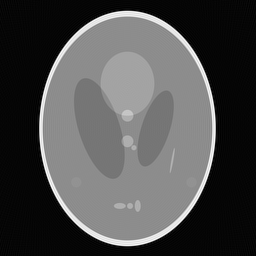
Dr.-Ing. Robert Grimm
Alumnus of the Pattern Recognition Lab of the Friedrich-Alexander-Universität Erlangen-Nürnberg
CG_DESCENT is a nolinear conjugate gradient optimizer with guaranteed descent. The authors William W. Hager and Hongchao Zhang provide relevant publications along with a C implementation on their ![]() website at UFL.
website at UFL.
However, it doesn't (yet?) come with a callback interface like the one provided by ![]() libLBFGS. This makes it difficult to use it in applications that could otherwise be parallelized easily by simultaneously running independent CG_DESCENT optimization processes in parallel. As an example, consider iterative 3D MR image reconstruction, where the reconstruction of each slice in the volume can be treated separately due to data independence.
libLBFGS. This makes it difficult to use it in applications that could otherwise be parallelized easily by simultaneously running independent CG_DESCENT optimization processes in parallel. As an example, consider iterative 3D MR image reconstruction, where the reconstruction of each slice in the volume can be treated separately due to data independence.
Here is a patch that will add callback interfaces to CG_DESCENT. Just ![]() download the patch, move it to a freshly installed directory of the
download the patch, move it to a freshly installed directory of the ![]() CG_DESCENT-6.2 source code, and run the following command:
CG_DESCENT-6.2 source code, and run the following command:
$ patch -p1 <CG_DESCENT-6.2-callbacks.patch
The patch will modify the interfaces in cg_descent.c, cg_descent.h and cg_user.h. The patched driver1.c shows how to handle the modified interface in existing code. The newly added driver6.cpp provides a simple example program demonstrating the use of cg_descent in an OpenMP-threaded application.
Please report any problems or bugs to robert.grimm(at)cs.fau.de.
-
Recently, novel Compressed Sensing methods have been proposed that promise very high undersampling factors in the spatial as well as temporal domain. However, it is unclear if these advanced reconstruction techniques preserve the true dynamics of the contrast enhancement, which otherwise could have significant impact on the quantitative analysis of the contrast-agent kinetics. In the latter case, a noisy image that reflects the true underlying dynamics would be more favorable than a beautified image that shows less noise and undersampling artifacts but deviates from the true course of contrast enhancement. To investigate these effects, we developed an extension to the well-known analytical Shepp-Logan phantom in the temporal dimension to simulate contrast enhancement in arteries and in healthy and pathological tissue. Unlike image-based approaches, a k-space based phantom allows for accurate sampling along arbitrary trajectories. This enables assessing the influence of k-space sampling strategies as well as the evaluation of reconstruction techniques for dynamic imaging. MATLAB source code for the phantom as well as for the generation of the contrast dynamics will be made available online
 here.
here. Related Publication:Proceedings of International Society for Magnetic Resonance in Medicine (ISMRM 20th Annual Meeting), Melbourne (Australia), May 5-11, pp. 2559, 2012 (BiBTeX, Who cited this?)
Related Publication:Proceedings of International Society for Magnetic Resonance in Medicine (ISMRM 20th Annual Meeting), Melbourne (Australia), May 5-11, pp. 2559, 2012 (BiBTeX, Who cited this?)




